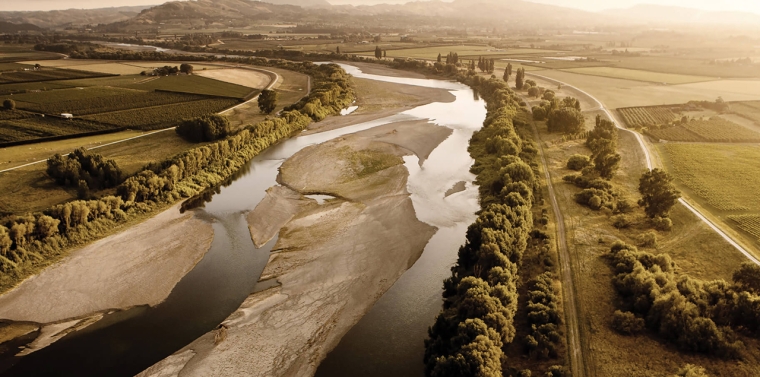
While the Hawke's Bay’s Ruataniwha dam is well and truly off the table there still is some hope that Hawke's Bay may yet receive some of the benefits irrigation can bring.
The Provincial Growth Fund announced this week that $64 million is being invested into Hawke's Bay and of that nearly half ($30.6 mln) is going into water security projects.
Developing a managed aquifer recharge (MAR) by ‘diverting’ surplus water at times of high flow and using it to recharge the aquifer will use nearly half of the $30.6. The bulk of the balance is targeted for investigating options for small-scale water storage options to supplement water flows in and across the Heretaunga Plains.
This announcement is timely as later this month (25th June) Waipawa is hosting a “land diversification” forum. The list of expert speakers shows that intensive and irrigated land use is not all about dairy farming with confirmed speakers:
CHB Mayor Alex Walker - MC
Richard Barge – Hemp Industry Association
Simon White – Kanapu Hemp
Jason Judkins – Hop Revolution
Tim Hermann – MPI - Sustainable Food and Fibres Fund
Vaughan Judkins – BerryCo
Boyd Gross - Logan Stone
Con Williams - MyFarm Investments
Greg Duncan - PyrethrumNZ
Hadley Boyle - Evertree Angora Goat Farming
Brendan Powell - Hawke's Bay Regional Council
Colin Pirie - Habitat Biodiversity and Fresh Air Forests
Sarah Reo - Te Kahui Ohanga o Takitimu
Farley Keenan - Te Puni Kokiri
Ian Millner - Rural Directions
It would be interesting to know if some of the PGF can or will be used to investigate the marketing end of some of these options as the production while important is nothing without an integrated value chain.
Discount retailing
The news that Costco, the USA’s second largest discount retailer is coming to New Zealand has hit the headlines. Opening date is still two years off assuming consents etc go to plan. Having another major grocer and general retailer in the Auckland region will certainly apply pressure to the two other major companies (Progressive and Foodstuffs) to lower prices to keep consumers coming through the doors.
My first thoughts were while this may be good for Auckland consumers it may have the reverse effect for the provinces (everywhere apart from Auckland).
Progressive and Foodstuffs will not see their margins reduce without a fight and while Costco have said that they are interested in expanding into Wellington and the South Island, presumably Christchurch, that will be many years away. If the pattern follows that of the petrol retailers when Auckland margins are squeezed through additional competition, then prices and margins will increase elsewhere where competition is less to make up the shortfalls.
Unlike fuel where the supply comes from pretty much a single source, groceries have multiple sources. This will allow the food retailers to work both ends of the value chain. Not only can they push-up prices to the consumer they can also try to ‘screw down’ what they pay for produce, especially the fresh stuff. I can recall some years ago seeing the figures that for an average supermarket fresh produce makes up about 10% of cash through-put but around 30% of profits and I suspect nothing has changed in the meantime. So what may be a windfall for Auckland producers and consumers may not translate that way elsewhere, at least until the competition spreads out. One redeeming feature maybe that in the USA one review highlights that while Costco certainly provide cheaper frozen product when it comes to the fresh stuff they are quite a way behind other fresh product suppliers.
Live livestock export review
MPI through the Minister Damien O’Connor are considering banning the export of live animals from New Zealand. Ironically this appears to be driven largely by the management, or lack of, of the countries who are receiving the animals as highlighted by the stories coming out of Sri Lanka where dairy cattle sent to stock local farms had high death rates largely, it appears, through the lack of skills by local farmers.
Last year New Zealand exported nearly 14,500 live cattle with a death rate en route of 0.06%. Anyone who is familiar with livestock will know that this is a very low rate and reflects well on the process at that stage. In 2016 over 40,000 cattle were exported so it appears numbers are reducing for a range of reasons so this decision if and when it comes in may not raise too much resistance.
The trade, worth $30 million last year, was of animals being sent mainly to China (the Sri Lanka episode was pre 2018) to be used for breeding rather than for slaughter which is what the majority of Australian cattle are exported (to Indonesia) for.
Australia exported nearly 900,000 cattle (94% for beef) for a A$1.1 billion return, a totally different scale to New Zealand and a trade that has attracted its fair share of criticism of both the shipment conditions as well as treatment when arriving at their destination.
What is not revealed from the Beehive release is does this ban extend to livestock be exported by air shipment? An expensive mode of transport reserved for high value animals this option should be retained. While it may be agreed that stewardship of animals extends well beyond the farm gate it should be able to be assumed that at some point the responsibility crosses over to the purchaser.
The Sri Lankan example highlights the issue when dealing with developing nations that may lack skills and in some cases do not share the same values when it comes to animal welfare (not looking at Sri Lanka here but Middle East examples with the now defunct sheep live export trade certainly fell within this category) and so in these situations it is a case of seller beware.
With New Zealand trying to lift the standard of both perceived and real treatment of animals it can be seen where this (likely) MPI decision is coming from.
2 Comments
Interesting but misleading title to this article. Basically, the wrong end of the stick.
Ag, thinking widely, is one of the four core human activities - those that, without which, TEOTWAWKI occurs. The four?
- Agriculture and food production
- Shelter - housing, cities and related infrastructure
- Transport - to link the often widely dispersed Food and Shelter locations and keep them supplied
- Security - to ensure that Production, Transport and Consumption are not compromised by the default human configuration of Violent Tribes
So all of these react mostly to Demand, and Resources available. 'Messing with' implies some sort of negative disturbance to either. But as the article makes clear, increasing Resource (by way of stored water) is hardly a negative for Ag. The Costco example is a quite nebulous effect on Pricing to Ag suppliers, to which they will react as always - seeking best prices elsewhere if at all possible. And the Livestock export is a rounding error in the grand scheme of things, as a PGG Wrightson spokesperson noted on RNZ this morning.
Messing? Nah - just the usual Gubmint to and fro. The Core Four carry on, regardless.
There is a difference between water-storage for CC and other-event resilience, and water-storage to flush dairy-pollution into waterways, just to increase $$$$$$$$$$$$$$ collection
On a case by case basis, I favour the first type. The danger is that they get privatised by nudge-nudge-wink-wink or by outbidding.
The Costco business model only worked in the old paradigm. Local produce and eyeball transactions are the future





We welcome your comments below. If you are not already registered, please register to comment.
Remember we welcome robust, respectful and insightful debate. We don't welcome abusive or defamatory comments and will de-register those repeatedly making such comments. Our current comment policy is here.